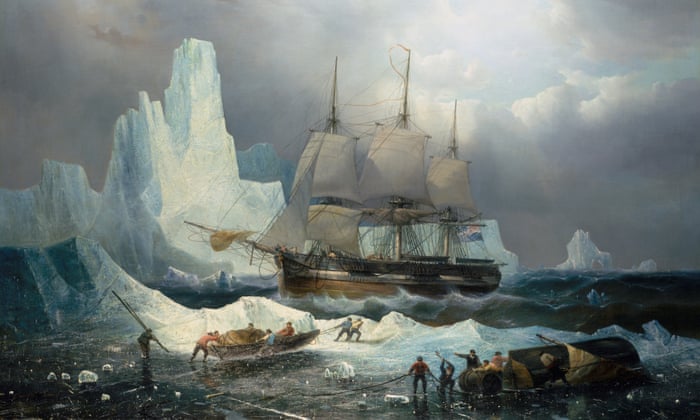
Erebus: The Story of a Ship by Michael Palin – review
The TV star’s vivid memoir of HMS Erebus and its epic polar expeditions is lively and diligentSara Wheeler
The Observer
Sun 30 Sep 2018
Biographies of ships are very much of the moment – volumes on Endeavour and the Japanese battleship Yamato have appeared recently – and now Michael Palin heaves into view with another one. His book tells the story of HMS Erebus, pioneer of both polar regions. This lively account reveals much about both exploration and the Royal Navy in the 19th century.
In September 2014, marine archaeologists discovered HMS Erebus, her snapped stern furred with algae, on the Arctic seabed. Palin starts there and works back. Labourers at the Pembroke dockyard built the broad-hulled warship and sent it into the waters off Milford Haven in June 1826. It was named after the son of the mythological Chaos; not a big ship, at 32 metres (104ft) it was less than half the length of a standard man-o’-war, and, as Palin says, “at 372 tons she was a minnow compared to Nelson’s 2,141 ton Victory”. Erebus was the last but one of the warships known as bomb vessels, able to fling shells over coastal defences.
Palin is strong on historical context. After Waterloo, the navy was at a loose end. Erebus spent two years patrolling the Mediterranean “to annoy the Turks”, then its life as a warship ended. In September 1839, accompanied by HMS Terror, it dropped her pilot off Deal in Kent and spent four years on an Antarctic adventure, where the dashing James Clark Ross captained her to the Barrier, or the Ross ice shelf as it was then known. The crew enjoyed a double allowance of rum to celebrate Queen Victoria’s birthday. It is hard to imagine what the Erebus crew thought and felt as they sailed along the 30-metre (98ft) high ice cliffs of this shelf the size of France.
Erebus and Terror were the first sailing ships to break through the pack and the first to discover that an Antarctic continent existed. They didn’t make their goal of the south magnetic pole but, writes Palin, “never again, in the annals of the sea, would a ship, under sail alone, come close to matching what she [Erebus] and Terror had achieved”.

On its way south, the three-masted Erebus had stopped off at Tasmania, then Van Diemen’s Land, and met the useless Lt Governor John Franklin. It was Franklin who later captained Erebus on its final mission (by then installed with a steam-driven, screw-propeller system), a doomed assault on the Northwest Passage, the fabled trade route to the riches of Cathay, again accompanied by the loyal Terror. That story begins two-thirds of the way through Palin’s book. It is a well-known tale, replete with human bones in kettles, plucky Inuit recounting meetings with starving white men who stagger around after their ships have sunk and the efforts of Lady Jane Franklin (she of the terrible handwriting, to anyone that has researched the archives) to dispatch rescue ships. Palin makes it his own. It is an epic story, full of appalling human suffering (everyone died) and one constantly revised as fresh discoveries float to the surface.
The prose style is fluent, though Palin might have allowed himself more jokes and fewer anachronisms (“on all accounts a bit of a drip”; “there was no plan B”). As always, there are far more officer sources (notably here Robert McCormick and the genius naturalist Joseph Dalton Hooker) than those of regular seamen. But Palin does his best, accessing, for example, the diaries of Mne Sgt Cunningham and the muster books and description books kept by the paymaster and purser on every navy ship.

Erebus: The Story of a Ship is a fugue in many voices. Palin assesses the role of the ship’s various commanders and understands the importance of anchoring his prose in specificity and detail. Who slept in hammocks? What did boiled dolphin taste like? When they suspended joints of beef under the mizzen-top in a bread bag for many months, was it good so far from home? Nautical information functions as ballast for the narrative: “Her hull was strengthened with 6-inch thick oak planking, increasing to 8 inches at the gunwale, to make a 3-foot-wide girdle”, and so on. Seven marines accompanied both Erebus and Terror on their Antarctic missions to guard against insubordination. As Palin writes: “There were no marines on the Bounty.”
Palin is a diligent researcher who has trawled the primary sources and, largely in the course of filming his television series Pole to Pole, has visited many of the key sites here. “I feel the connection,” he writes, “between then and now. Between Erebus and me.” Daguerreotypes appeared in the six years between the Ross and Franklin expeditions and the excellent colour plate sections in this book are revealing.
Sun 30 Sep 2018
Biographies of ships are very much of the moment – volumes on Endeavour and the Japanese battleship Yamato have appeared recently – and now Michael Palin heaves into view with another one. His book tells the story of HMS Erebus, pioneer of both polar regions. This lively account reveals much about both exploration and the Royal Navy in the 19th century.
In September 2014, marine archaeologists discovered HMS Erebus, her snapped stern furred with algae, on the Arctic seabed. Palin starts there and works back. Labourers at the Pembroke dockyard built the broad-hulled warship and sent it into the waters off Milford Haven in June 1826. It was named after the son of the mythological Chaos; not a big ship, at 32 metres (104ft) it was less than half the length of a standard man-o’-war, and, as Palin says, “at 372 tons she was a minnow compared to Nelson’s 2,141 ton Victory”. Erebus was the last but one of the warships known as bomb vessels, able to fling shells over coastal defences.
Palin is strong on historical context. After Waterloo, the navy was at a loose end. Erebus spent two years patrolling the Mediterranean “to annoy the Turks”, then its life as a warship ended. In September 1839, accompanied by HMS Terror, it dropped her pilot off Deal in Kent and spent four years on an Antarctic adventure, where the dashing James Clark Ross captained her to the Barrier, or the Ross ice shelf as it was then known. The crew enjoyed a double allowance of rum to celebrate Queen Victoria’s birthday. It is hard to imagine what the Erebus crew thought and felt as they sailed along the 30-metre (98ft) high ice cliffs of this shelf the size of France.
Erebus and Terror were the first sailing ships to break through the pack and the first to discover that an Antarctic continent existed. They didn’t make their goal of the south magnetic pole but, writes Palin, “never again, in the annals of the sea, would a ship, under sail alone, come close to matching what she [Erebus] and Terror had achieved”.

On its way south, the three-masted Erebus had stopped off at Tasmania, then Van Diemen’s Land, and met the useless Lt Governor John Franklin. It was Franklin who later captained Erebus on its final mission (by then installed with a steam-driven, screw-propeller system), a doomed assault on the Northwest Passage, the fabled trade route to the riches of Cathay, again accompanied by the loyal Terror. That story begins two-thirds of the way through Palin’s book. It is a well-known tale, replete with human bones in kettles, plucky Inuit recounting meetings with starving white men who stagger around after their ships have sunk and the efforts of Lady Jane Franklin (she of the terrible handwriting, to anyone that has researched the archives) to dispatch rescue ships. Palin makes it his own. It is an epic story, full of appalling human suffering (everyone died) and one constantly revised as fresh discoveries float to the surface.
The prose style is fluent, though Palin might have allowed himself more jokes and fewer anachronisms (“on all accounts a bit of a drip”; “there was no plan B”). As always, there are far more officer sources (notably here Robert McCormick and the genius naturalist Joseph Dalton Hooker) than those of regular seamen. But Palin does his best, accessing, for example, the diaries of Mne Sgt Cunningham and the muster books and description books kept by the paymaster and purser on every navy ship.

Erebus: The Story of a Ship is a fugue in many voices. Palin assesses the role of the ship’s various commanders and understands the importance of anchoring his prose in specificity and detail. Who slept in hammocks? What did boiled dolphin taste like? When they suspended joints of beef under the mizzen-top in a bread bag for many months, was it good so far from home? Nautical information functions as ballast for the narrative: “Her hull was strengthened with 6-inch thick oak planking, increasing to 8 inches at the gunwale, to make a 3-foot-wide girdle”, and so on. Seven marines accompanied both Erebus and Terror on their Antarctic missions to guard against insubordination. As Palin writes: “There were no marines on the Bounty.”
Palin is a diligent researcher who has trawled the primary sources and, largely in the course of filming his television series Pole to Pole, has visited many of the key sites here. “I feel the connection,” he writes, “between then and now. Between Erebus and me.” Daguerreotypes appeared in the six years between the Ross and Franklin expeditions and the excellent colour plate sections in this book are revealing.









No comments:
Post a Comment